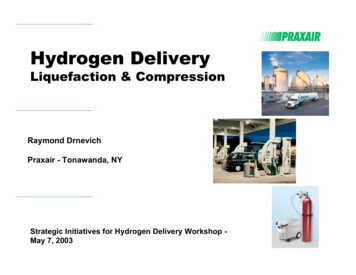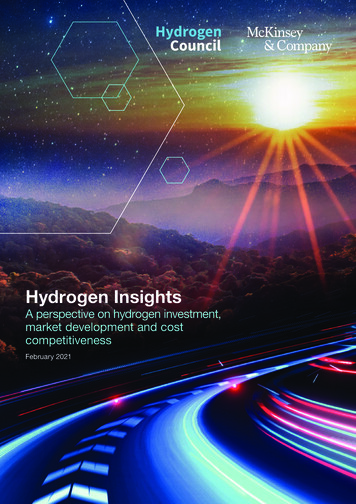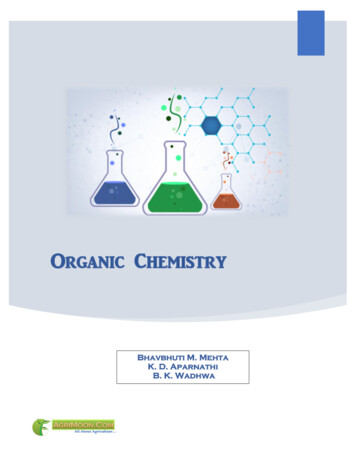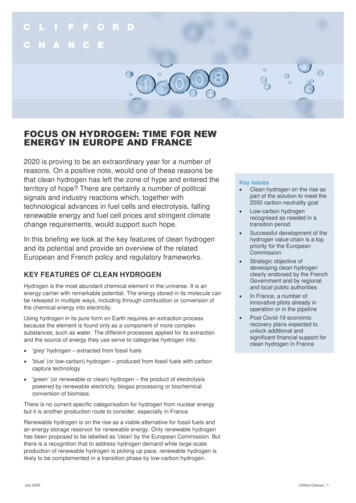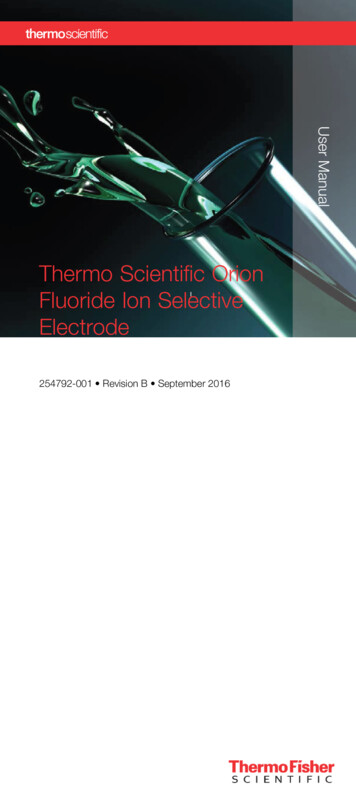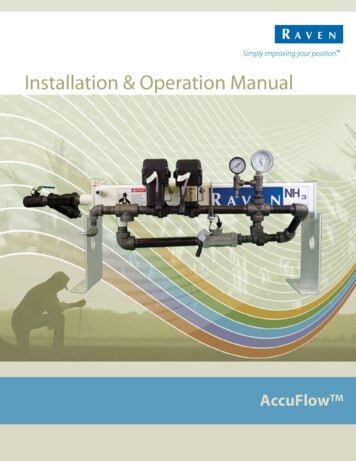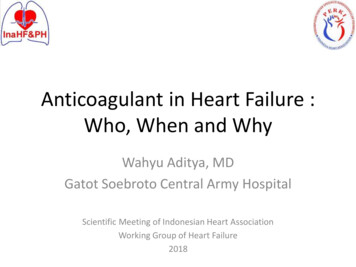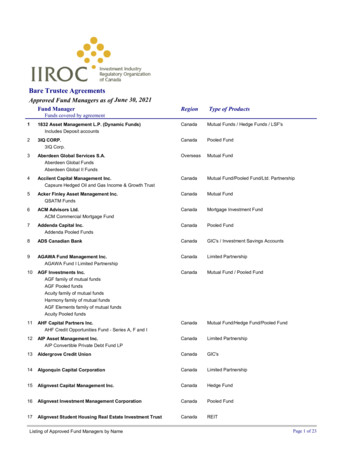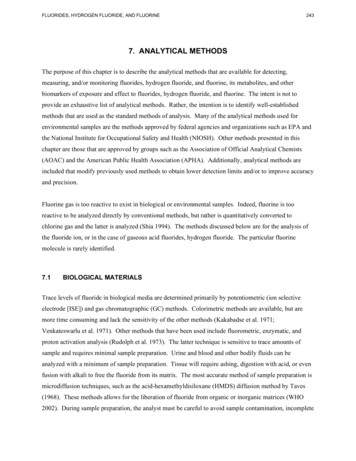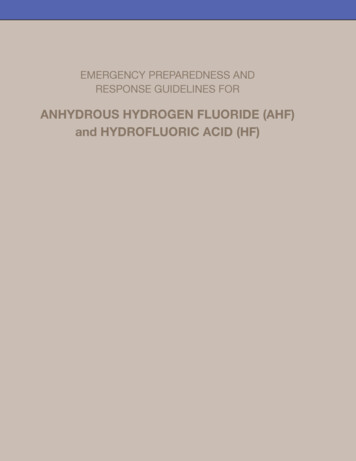
Transcription
EMERGENCY PREPAREDNESS ANDRESPONSE GUIDELINES FORANHYDROUS HYDROGEN FLUORIDE (AHF)and HYDROFLUORIC ACID (HF)
October 2018Hydrogen Fluoride PanelAmerican Chemistry Council 700 Second Street, NE, 20002Washington, DC
Table of Contents1.0 Introduction49.3 Hot/Cold Taps211.1 Legal Notice49.4 Venting/Field Scrubbing211.2 To the Reader51.3 Purpose and Use of Guidelines510.0 Decontamination of Transfer Equipment2210.1 Purging/Evacuating to Non-Fuming Condition222.0 Chemical Identification, Production, and Use610.2 Flushing with Neutralizing Solutions222.1 Chemical Identification610.3 Sealing Equipment for Transportation222.2 Production of HF610.4 Transporting Cleaning Effluents222.3 Uses for HF710.5 Decontamination of PPE223.0 Environmental Fate and Effects74.1 Health Factors8APPENDIX A234.1.1 General Health Information8Physical Properties and Characteristics of AHF,70% HF, and 49% HF234.0 Health Factors, Industrial Hygiene, and First Aid8APPENDIX B244.1.2 Acute Inhalation Exposure9Examples of Specific HF Product Applications244.1.3 Skin Exposure94.1.4 Eye Exposure9APPENDIX C254.1.5 Chronic Hazard9Description of AHF Tank Car25APPENDIX D26Description of AHF Tank Trailer26APPENDIX E275.0 Personal Protective Equipment115.1 Protective Clothing115.2 Respiratory Protection115.3 Decontamination116.1 Specific Emergency Response Considerations12Description of Hydrofluoric Acid Solution(Aqueous HF) Cargo Tank276.0 Emergency Response12APPENDIX F286.2 Reporting Requirements14Description of ISO Containers287.0 Damage Assessment16APPENDIX G297.1 Introduction16References to Regulations and Other Guidance297.2 Primary Assessment167.3 Secondary Assessment16APPENDIX H308.0 Leaks188.1 Type of HF Leak (Vapor or Liquid)18Typical Exposure Management Flowcharts(Decontamination, Evaluation, First Aid andMedical Treatment)308.2 Leak Locations18APPENDIX I358.3 Compatible Equipment and Materials18Personnel Decontamination Procedures358.4 Techniques/Equipment Used to Address Leaks18APPENDIX J379.0 Emergency Transloading20Definitions and Acronyms379.1 Introduction20Hydrogen Fluoride Panel409.2 Using Existing Valves and Fittings on Non-leakingContainers20October 2018AHF Emergency Response Guidelines3
1.0 Introduction1.1Legal NoticeThe Emergency Preparedness and ResponseGuidelines for Anhydrous Hydrogen Fluoride andHydrofluoric Acid (Guidelines) were prepared bythe American Chemistry Council’s (ACC) HydrogenFluoride Panel (Panel). This document is intended toprovide general information to persons addressingan emergency response in the course of handlingand transporting anhydrous hydrogen fluoride (AHF)or hydrofluoric acid (HF). It is not intended to serveas a substitute for in-depth training or specific requirements, nor is it designed or intended to defineor create legal rights or obligations. It is not intended to be a “how-to” manual, nor is it a prescriptiveguide. All persons involved in handling and transporting AHF or HF have an independent obligationto ascertain that their actions are in compliance withcurrent federal, state and local laws and regulationsand should consult with legal counsel concerningsuch matters. The Guidelines are necessarily generalin nature and individual companies may vary theirapproach with respect to particular practices basedon specific factual circumstance, the practicality andeffectiveness of particular actions, and economicand technological feasibility. Any mention of specific products in these Guidelines are for illustrationpurposes only, and are not intended as a recommendation or endorsement of such products.or any member companies assume any liability orresponsibility for any use or misuse, or the results ofsuch use or misuse, of any information, procedure,conclusion, opinion, product, or process disclosedin this manual. NO WARRANTIES ARE GIVEN; ALLIMPLIED WARRANTIES OF MERCHANTABILITYOR FITNESS FOR A PARTICULAR PURPOSE AREEXPRESSLY EXCLUDED.This work is protected by copyright. The American Chemistry Council, which is the owner of thecopyright, hereby grants a nonexclusive royalty-freelicense to reproduce and distribute these Guidelines, subject to the following limitations:1. The work must be reproduced in its entirety,without alterations.2. All copies of the work must include a cover pagebearing American Chemistry Council’s notice ofcopyright and this notice.3. Copies of the work may not be sold.For more information on material presented in thismanual, please contact an AHF or HF supplier.Copyright 2018 American Chemistry Council, allrights reserved.Neither the American Chemistry Council, nor theindividual member companies of the HydrogenFluoride Panel, nor any of their respective directors,officers, employees, subcontractors, consultants, orother assigns, makes any warranty or representation,either express or implied, with respect to the accuracy or completeness of the information contained inthis manual; nor do the American Chemistry Council4AHF Emergency Response GuidelinesOctober 2018
1.2To the ReaderAs members and affiliated companies of the American Chemistry Council, the Hydrogen Fluoride Panelsupports efforts to improve the industry’s responsiblemanagement of chemicals. To assist in this effort, ThePanel supported the creation and publication of theseGuidelines. The Panel is composed of the followingcompanies:Arkema Inc.ChemoursDaikin America, Inc.DuPont1.33MHoneywellMexichem SA de CVSolvay Fluorides, LLCPurpose and Use of GuidelinesThese Guidelines have been developed for use byproducers and industrial users of AHF or HF, chemical companies and independent or contractor emergency response personnel, ACC’s CHEMTREC ,Local Emergency Planning Committees (LEPCs),and transporters of AHF or HF and their emergencyresponse personnel.The purpose of this product stewardship documentis to provide the reader with a better understandingof the properties of AHF or HF to serve as a resourcein the development of producers’ and users’ design,operation, maintenance, training and emergency response practices. References to applicableregulations and industry practices are made in thetext, tables, figures, and appendices, as appropriate.Contact an AHF or HF supplier for further information as necessary.This edition of the Guidelines, issued in 2018, is thethird edition. It is available on the internet at www.americanchemistry.com/hydrogenfluoride. It mayalso be available through an AHF or HF supplier onits individual company website. This document maybe updated. Readers should stay abreast of newdevelopments and information about AHF or HF,including but not limited to physical properties, handling technology, medical treatment, and regulatoryrequirements that occur after the date of publicationof this document.Contact an AHF or HF supplier or visithttps://www.americanchemistry.com/hfpanel/ toobtain the most current version of these Guidelines,for questions, or to get more information about anyinformation presented in this document. The Hydrogen Fluoride Panel encourages comments onthe content of this document and a more in-depthdialogue concerning the issues presented.October 2018AHF Emergency Response Guidelines5
2.0 Chemical Identification, Production, and Use2.1Chemical IdentificationHydrogen fluoride (HF)1 is a colorless gas at temperatures above about 67ºF (19.5ºC), and a clear,colorless, corrosive, fuming liquid at lower temperatures. It has an extremely acrid odor. ReleasedAHF will quickly volatilize in air at room temperature,forming dense white vapor clouds that may rise orfall.2 Released 50% or HF will quickly form a whitevapor cloud.SubstanceHydrogen FluorideChemicalAbstractService RegistryNumber (CASRN)7664-39-3GroupInorganic CorrosiveSynonymsanhydrous hydrofluoric acidaqueous hydrogen fluorideantisal 2Bhydrofluoridehydrofluoric acidfluorhydric acidfluorohydric acidfluoric acidfluorideHFHF-AAHFRTECSClaireconfirmed numberMW7875000UN#1052 (anhydrous);1790 (solution)DOT ID (Guide #)1052 (125) (anhydrous)1790 (157) (solution)HF readily dissolves in water to form colorless hydrofluoric acid solutions; dilute solutions are visiblyindistinguishable from water. It is highly soluble inalcohol and many organic compounds.Undiluted, or pure, HF is often referred to as anhydrous hydrogen fluoride3 or AHF, while solutions ofHF in water are generally referred to as hydrofluoricacid or by the percentage of HF in the solution, suchas “70% HF” or “49% HF.” 70% and 49% HF arethe most commonly available commercial concentrations in North America. See Appendix A for moreinformation on the physical properties and characteristics of AHF, 70% HF, and 49% HF.Source: Web Elements http://www.webelements.comHF is highly reactive with many substances. It ishighly corrosive, and contact between HF andmetals, glass, concrete, silica, strong bases, sodiumhydroxide, potassium hydroxide, ceramics, leather,natural rubber, and other materials may result in1 The chemical structure of hydrogen fluoride is H-F,molecular weight 20.01. HF may exist in complexes orpolymers, such as HF, due to hydrogen binding.2 The NIOSH Pocket Guide to chemical hazardsdescribes HF as a colorless gas or fuming liquid below67ºF. http://www.cdc.gov/niosh/npg/npgd0334.html.(Note that solutions containing HF will also fume in air,with fuming reported for HF concentrations of at least48%).3 “Anhydrous” means “without water.”6AHF Emergency Response Guidelinesviolent reactions. Due to these properties, safetyconsiderations, and extensive industry experience,AHF is usually shipped in steel cylinders and otherpres sure rated bulk containers. See Appendices Cand D for specific recommendations. If stored, it isstored in corrosion-resistant containers. It shouldalso be noted that the corrosive action of HF on metals can result in the formation of hydrogen gas.2.2Production of HFIn industrial settings, HF is generally derived fromthe reaction of concentrated sulphuric acid (H2SO4)on fluorspar (CaF2). The process generally used isto react 93 to 99 percent sulfuric acid and pulverizedacid grade fluorspar (calcium fluoride). The reactionoccurs in a heated rotary kiln at a controlled temperature for approximately 30 to 60 minutes. Thereaction products are hydrogen fluoride gas andcalcium sulfate.Once it is produced, AHF can be shipped by a variety of methods. As noted above, due to the reactivity of the material, it is generally shipped in a steelcontainer or vessel. In North America, approximatelyOctober 2018
85 to 90 percent of AHF is shipped in rail cars, withthe remainder shipped in tank trucks (cargo tanks),portable tanks, and cylinders. The majority of AHFproduced in the United States originates from twoGulf Coast area facilities. Significant quantities arealso imported into the United States from Mexico.2.3Uses for HFHF is an essential commercial chemical that servesas a raw material, catalyst or processing agent formanufacture of the following materials: refrigerants, high-octane gasoline, aluminum, herbicides,pharmaceuticals, plastics, electronic components,and incandescent light bulbs. It is also used foretching glass and metal. In low concentrations (e.g.,2.5 to 12 percent), it is present in a variety of overthe-counter products available to consumers. SeeAppendix B for examples of specific product applications for HF.October 20183.0 E nvironmental Fateand EffectsHF is very reactive in the environment and quicklyforms salts. When HF is released into the atmosphere, it will react and dissociate on contact withsoils, water, structures and all living matter. Plantsand some wildlife are susceptible to HF exposure.Very low HF vapor concentrations (0.1 to 0.5 ppm)can injure or kill vegetation. Birds are very susceptible due to their high respiratory rates. Fish can be affected with very low fluoride concentration in water.AHF Emergency Response Guidelines7
4.0 Health Factors, Industrial Hygiene, and First Aid4.1Health FactorsThis section provides a brief overview of information pertaining to potential acute (short term) healthhazards associated with exposure to HF. A comprehensive discussion of health effects informationpertaining to HF is beyond the scope of these guidelines. For more information, contact a supplier of HF.Additional information, including first aid information,also may be found in the supplier’s Safety DataSheet (SDS).There are many excellent resources available for developing a plan to treat HF exposures. For example,ATSDR’s Medical Management Guidelines for Hydrogen Fluoride can be a useful guidance tool,4 and theAustralian National Occupational Health and SafetyCommission has also published a useful resourcetool. The HF manufacturer’s Safety Data Sheet (SDS)will also include specific first aid instructions; first aidinstructions on an SDS accompanying HF should befollowed.Development of a first aid plan should be done inconsultation with appropriately trained medicalpersonnel. To facilitate proper and timely first aidtreatment, it can be useful to arrange in advance andhave available medical receiving facilities and namesof physicians (backup as well as primary) trained inHF emergency treatment.It is noted that specific first aid procedures may varybased on fact-specific circumstances, recommendations of trained medical personnel, and other factors.Another useful component of a first aid program canbe to develop exposure route flowcharts. Severalexamples are reproduced in Appendix I. Personaldecontamination procedures used by some HF manufacturers are included in Appendix J.For more general information about potential healtheffects of hydrogen fluoride, consult resources suchas the U.S. Center for Disease Control’s Fact Sheetabout Hydrogen Fluoride5; ATSDR’s Toxicity Profileon Fluorides6, European Union HF Risk Assessment7,4 ATSDR’s Medical Management Guidelines for Hydrogen Fluoride5 U.S. Center for Disease Control’s Fact Sheet aboutHydrogen Fluoride6 ATSDR’s Toxicity Profile on Fluorides7 European Union HF Risk Assessment8AHF Emergency Response Guidelinesand Australian National Occupational Health andSafety Commission’s Guide to Hydrogen Fluoride8.4.1.1 General Health InformationHydrogen Fluoride or HF is extremely hazardousin both liquid and vapor states. See Appendix I fordetails on emergency first aid procedures. Contactwith HF requires specialized treatment. It can causesevere injury to any tissue with which it comes incontact (chemical burn). Exposure by contact withskin, or by inhalation or ingestion, can lead to severetoxic systemic effects (Acute Fluoride Intoxication)and potentially death. Eye contact from vapor or liquid can result in blindness if not treated immediately.Death can occur from severe electrolytic imbalance(hypocalcemia and hypomagnesemia) that leads tocardiac arrhythmia (fibrillation), which, in turn, canlead to cardio-respiratory arrest.HF penetrates tissue quickly and can penetrate alllevels of the skin within a few minutes. HF rapidlydissociates into hydrogen and fluoride ions. Withinthe body, the disassociated fluoride ion will preferentially bind to calcium (and to a lesser extent magnesium). Depletion of serum calcium and magnesiummay cause serious toxic systemic effects. Washingthe exposed tissue with water does not neutralizeHF and cannot reverse the skin penetration. Whileprompt water washing is required for initial decontamination, HF-specific first aid treatments bind thefluoride to calcium, and rapidly starting such treatments is critical to stopping further tissue damage.The local (harm to the part of the body a substancecomes into contact with) and systemic (harm thatchanges the function of other organs) toxic effectsthat can occur following exposure to HF will varywidely depending on the concentration of HF, duration and route of exposure. Effects may range frommild and reversible, such as mild irritation of the skin,eyes and respiratory tract, to serious and potentiallylife- threatening.Hyperkalemia (excessive concentration of potassiumin the exposed area) is often cited as the cause ofintense pain.8Safety Commission’s Guide to Hydrogen FluorideOctober 2018
4.1.2 Acute Inhalation ExposureInhalation of HF results in upper airway irritationin the nose and throat. More significant exposuresmay result in coughing and pain under the sternum.Exposure to low concentrations of HF can resultin irritation of nasal passages, dryness and bleeding from the nose. While continued exposure tolow concentrations can result in an ulcerated andperforated nasal septum, due to the irritant effects ofHF, employees are unlikely to tolerate this repeatedexposure.Significant inhalation exposures will almost alwaysresult in signs or symptoms of upper airway irritation,so deep lung injury is unlikely in the absence of upper airway irritation. The risk is in failing to recognizethe seriousness of an inhalation exposure as laryngeal and pulmonary edema may have delayed onset.Failure to recognize and treat an inhalation exposuremay result in discharging a patient who then progresses to laryngeal and/or pulmonary edema.In addition to the direct local effects on the lung,inhalation exposures pose a significant risk forsystemic toxicity. Close observation for respiratoryeffects and signs of systemic toxicity is warranted.4.1.3 Skin ExposureExposure to anhydrous or aqueous HF solutionsabove 50% will produce immediate burns. Lessconcentrated solutions may result in delayed burnswhich become apparent several hours followingexposure. With dilute solutions (5% or less), burnsmay not be immediately painful or visible, but maybe displayed 24 hours or more after exposure.4.1.4 Eye ExposureEye contact with HF results in a feeling of burning,redness, and secretion. Even a splash of a dilute HFsolution can quickly result in conjunctivitis, keratitis,or more serious destruction of eye tissue.4.1.5 Chronic HazardDue to the high corrosivity and irritant effects of HF,chronic exposures and associated health effects areunlikely.The U.S. Occupational Safety and Health Administration (OSHA) has set a permissible exposure limit(PEL) of 3 ppm, 8-hour, time-weighted average forHF. 8 The threshold limit value (TLV ) established bythe American Conference of Governmental Industrial Hygienists (ACGIH ) for HF is 2 ppm (Ceiling),October 20180.5 ppm 8 hr. TWA . The TLV refers to the airborneconcentration and represents the condition underwhich ACGIH believes that nearly all workers may berepeatedly exposed, day after day, without adversehealth effects. The value is a time-weighted average(TWA) concentration for an 8-hour workday and40-hour work week. It only serves as a guide in thecontrol of health hazards, and not as a fine line todistinguish between safe and dangerous concentrations. It should be noted that where the TLV is lowerthan the PEL, OSHA has taken the position in thepast that it will embrace the more restrictive limit anduse it in conjunction with the general duty clausein its enforcement role. TLVs, RELs, and PELs aresubject to change by their associated peer reviewgroups. As with other references in these Guidelines,users must check the current reference for up-todate information.EPA has issued Acute Exposure Guideline Levels, orAEGLs, for HF. AEGLs describe the risk to humans(general public) resulting from once-in-a-lifetime, orrare, exposure to airborne chemicals. The National Advisory Committee for AEGLs develops theseguidelines to help both national and local authorities,as well as private companies, deal with emergenciesinvolving spills, or other catastrophic exposures.Acute exposures are defined as single, non-repetitive exposures (emergency exposure periods) for notmore than eight hours. AEGL 1 is the airborne concentration (expressedas ppm and mg/m3) of a substance at or abovewhich it is predicted that the general population,including “susceptible” but excluding “hyper susceptible” individuals, could experience notablediscomfort. Airborne concentrations below AEGL1 represent exposure levels that could producemild odor, taste or other sensory irritations. AEGL 2 is the airborne concentration (expressedas ppm and mg/m3) of a substance at or abovewhich it is predicted that the general population,including “susceptible” but excluding “hypersusceptible” individuals, could experience irreversible or other serious, long-lasting effects orimpaired ability to escape. AEGL 3 is the airborne concentration (expressedas ppm and mg/m3) of a substance at or abovewhich it is predicted that the general population,including “susceptible” but excluding “hyper susceptible” individuals, could experience life-threatening effects or death.AHF Emergency Response Guidelines9
ACUTE EXPOSURE GUIDELINE LEVELS (AEGLs) for HFIssued by EPA National Advisory 4-Hour8-HourAEGL-1(Nondisabling)1 ppm(0.8 mg/m3)1 ppm(0.8 mg/m3)1 ppm(0.8 mg/m3)1 ppm(0.8 mg/m3)1 ppm(0.8 mg/m3)AEGL-2(Disabling)95 ppm(78 mg/m3)34 ppm(28 mg/m3)24 ppm(20 mg/m3)12 ppm(9.8 mg/m3)12 ppm(9.8 mg/m3)AEGL-3(Lethal)170 ppm(139 mg/m3)62 ppm(51 mg/m3)44 ppm(36 mg/m3)22 ppm(18 mg/m3)22 ppm(18 mg/m3 )The American Industrial Hygiene Association (AIHA)publishes Emergency Response Planning Guidelines (ERPGs). These guidelines set one-hourexposure limits for effects on the general public foruse in emergency response situations. ERPG-1 isthe allowable concentration for mild transient effectsor objectionable odor (discomfort). ERPG-2 is theconcentration for serious health effects or impairedability to take protective action (disability). ERPG-3is the allowable concentration for life-threateningeffects (death).The National Institute for Occupational Safety andHealth (NIOSH) has set an IDLH (immediately dan-gerous to life or health) level for HF at 30 ppm. Thecurrent NIOSH definition for an immediately dangerous to life or health condition is a situation “thatposes a threat of exposure to airborne contaminantswhen that exposure is likely to cause death or immediate or delayed permanent adverse health effects orprevent escape from such an environment.” NIOSH’sintention in setting an IDLH is to “ensure that theworker can escape from a given contaminatedenvironment in the event of failure of the respiratoryprotection equipment.” NIOSH’s respirator decisionlogic uses IDLH criteria to aid in the selection of respirators for emergency and certain other situations.EMERGENCY RESPONSE PLANNING GUIDELINES (ERPGs) for HFIssued by the American Industrial Hygiene Association10ERPG 1 (60 min)2 ppmERPG 1 (10 min)2 ppmERPG 2 (60 min)20 ppmERPG 2 (10 min)50 ppmERPG 3 (60 min)50 ppmERPG 3 (10 min)170 ppmAHF Emergency Response GuidelinesOctober 2018
5.0 P ersonal Protective EquipmentPersonal protective equipment (PPE) serves tocomplement but not substitute for engineeringcontrols including safe working conditions, adequateprocess control, ventilation and proper conduct byemployees working with HF. The appropriate selection and use of personal protective equipment willnormally consider the total and fact-specific situationin addition to the toxic properties of compounds towhich a worker may be exposed. These situationsmay involve the presence of other materials thatcan magnify potential concerns associated with HF.Therefore, the information presented in this sectionwith regard to PPE selection is to be consideredas a potential reference point for general guidance.Users need to select appropriate personal protectiveequipment based on their specific needs and circumstances. Other chemicals or factors may requirethe use of additional protection. Except in extremeemergencies, no one should be given personal protective equipment without suitable training.Location, care and selection of appropriate PPEare dictated by the proposed use of the equipment.Companies have assigned personnel, facilities andprograms for suitable care, decontamination and repair of all equipment. These programs include a process to check with the PPE manufacturer regardingthe suitability of the PPE and materials of construction for a particular use; in addition, they check thespecific use instructions and restrictions of the PPEmanufacturer. Companies provide training so thatemployees using PPE in HF service are extensivelyexperienced in the use of the relevant PPE prior toits use in HF service. Consult the manufacturer’sproduct use recommendations where provided.5.1Protective ClothingHF is highly corrosive and reactive, and rapidlypenetrates tissue with which it comes into contact.Workers in contact with HF should be aware of thepermeation, penetration, and degradation characteristics of HF on PPE and take appropriate precautions. In particular, workers should be aware of thelimits of PPE in HF service. For example, such PPEmay not be designed to come into contact with liquid streams of HF. Please contact your PPE supplierfor additional information.October 2018For HF, NIOSH’s recommendation for skin protectionis to prevent skin contact, and the recommendedprotective clothing barriers are Tychem (8 hour)and Teflon (4 hour). The Quick Selection Guide toChemical Protective Clothing also provides that thefollowing PPE designations would be appropriatewhere contact with HF is anticipated: Level A (fully encapsulating suit - highest level ofrespiratory, skin and eye protection).The Level A suit is ordinarily used in most emergencyresponse situations. Level A protection, when usedin compliance with the manufacturer’s instructionsand recommendations, should provide adequategaseous HF resistance (adequate penetration andpermeation times).The definitions of the four levels of PPE may befound in the Hazardous Waste Operations andEmergency Response (HAZWOPER) regulations, 49CFR §1910.120, Appendix B. More information isavailable in the Hydrogen Fluoride Industry PracticesInstitute’s (HFIPI) “Personal Protective EquipmentGuideline For Anhydrous Hydrogen Fluoride,” mostrecent edition.5.2Respiratory ProtectionThe Occupational Safety and Health Administration (OSHA) provided requirements for respiratoryprotective equipment. (See Title 29 CFR 1910.134as amended). Such equipment is carefully maintained, inspected, cleaned and disinfected at regularintervals and before use by another person. Consulta reliable safety equipment dealer for details on theproper use of approved equipment.In its Pocket Guide to Chemical Hazards, NIOSHmakes respirator recommendations for HF.5.3DecontaminationDecontamination of PPE following a response is animportant part of any Emergency Response Plan(ERP). For more detailed discussion, see Section10.6, Decontamination of PPE.AHF Emergency Response Guidelines11
6.0 Emergency ResponseEvery emergency situation will be different. It is notthe intention of these Guidelines to address everypotential emergency situation; it is intended to helpproducers, users, and others as a resource in thedevelopment of their own emergency procedures forresponding to an HF incident.Emergency responders must be properly trained andequipped in accordance with OSHA standards onemergency response and emergency fire protection(29 CFR 1910.38, 1910.120 and Subpart L). The firstpriority in responding to an emergency situation isthe safety of the emergency responders, employees,and people in the surrounding community. The second priority is to determine the incident’s impact onthe surrounding environment, and to set a strategyto stabilize the situation and minimize the impact.The third priority is the conservation or protection ofequipment and property.6.1 Specific Emergency ResponseConsiderations6.1.1Establishing Response PerimeterEstablishing an emergency response perimeter isa common feature of an emergency response plan.The DOT North American Emergency ResponseGuidebook provides the following guidance for incident isolation:6.1.1Establishing Response PerimeterFirstISOLATEin allDirectionsMeters (Feet)126.1.2Monitoring Wind DirectionAfter noting wind and weather conditions and whether fumes are visible from HF container, place the hotzone perimeter at an appropriate distance away fromvisible fumes.Monitoring wind and weather conditions is importantso that the hot zone perimeter can by appropriatelyidentified.*Caution* The Emergency Response Guidebookwas written for transportation emergencies. Theisolation and perimeter recommendations maynot be sufficient for releases that occur in fromstorage vessels or process equipment that couldcontain a higher volume of material thatHF vapor is heavier than air. However, the initialrelease may result in an exothermic reaction causingthe vapor cloud to temporarily rise.6.1.3Exposure LimitsSome known HF exposure limits are displayed below.Exposure Limits for HFOSHA (PEL)3 ppm, 8 hr TWAACGIH (TLV)2 ppm (1.7 mg/m3), CeilingACGIH (TLV)0.5 ppm (0.4 mg/m3), 8 hr TWA6.1.4Air Monitoring Equipment for HFThen PROTECT persons Downwind duringDayLow wind( 6 mph 10 km/h)km(miles)Moderate wind(6-12 mph 10-20 km/h)km(miles)NightHigh wind( 12 mph 20 km/h)Low wind( 6 mph 10 km/h)kmkm(miles)km(miles)km(miles)(miles)Moderate wind(6-12 mph 10-20 km/h)High wind( 12 mph 20 km/h)TransportContainerUN1052 Hydrogen fluoride, anhydrous: Large SpillsRailTank 8)1.9(1.2)Highwaytank truckor (1.0)0.9(0.6)Multiplesmallcylinders orsingle )0.5(0.3)0.3(0.2)AHF Emergency Response GuidelinesOctober 2018
6.1.4a Air Monitoring Equipment for HFDetector TubesGas Meter DisadvantagesPortableOne time use detector tubesPortableNo batteries orpower sourcerequiredNot continuous, gives only a“snapshot in time”ContinuousHF exposure higher thanrange will require recalibrationLarge number of detector tubesmay be neededTubes have limited shelf lifeQualitative measurements basedon color change in tubesData loggingcapabilitiesDirect readinginstrument(quantitative measure)Corr
10.0 Decontamination of Transfer Equipment 22 10.1 Purging/Evacuating to Non-Fuming Condition 22 10.2 Flushing with Neutralizing Solutions 22 10.3 Sealing Equipment for Transportation 22 10.4 Transporting Cleaning Effluents 22 10.5 Decontamination of PPE 22 APPENDIX A 23 Physical Properties and Characteristics of AHF, 70% HF, and 49% HF 23
